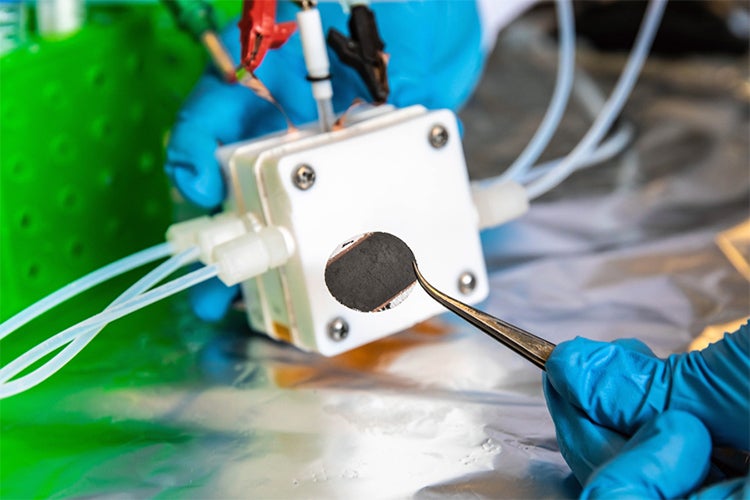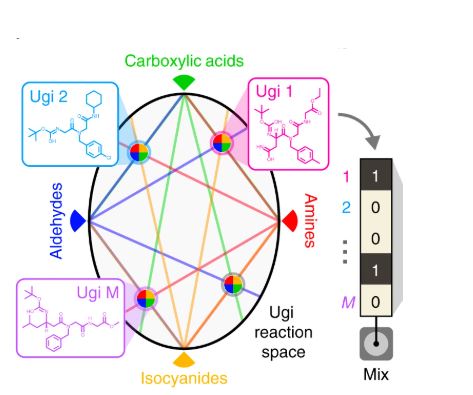(‘Reverse fuel cell’ built by U of T researchers converts waste carbon into valuable products)
2020-02-10 カナダ・トロント大学

・ トロント大学が、CO2 の電気分解でエチレン等の有用な化学物質を獲得する技術において、反応速度を高めた電解槽の設計を開発。
・ 電解槽を使用する同技術では、化学物質の利用で発電する燃料電池の働きをリバースし、電気を使用して化学物質を獲得する。あらゆる製品の製造に使用されるエチレンの原料を、化石燃料から CO2 にアップグレードすることで、炭素捕獲の経済的なインセンティブが新たに創出できると考える。
・ 現在の電解槽では、化石燃料に匹敵する規模でのエチレンの生産が不可能。この原因の一部には、CO2 をエチレンや他の炭素ベース分子に転換する化学反応の独特な性質がある。・ 同化学反応では、ガス状の CO2、水から得る水素イオン、そして金属製の触媒を通じて移動する電子が必要。これらの異なる 3 種類の反応物質のフェーズ(特に CO2)を一度に迅速に反応させることは難しく、これが反応速度を制限している。
・ この課題に対処するため、新設計の電解槽では、平坦な金属シート状の従来の銅ベース触媒をナフィオン(Nafion)の層に微小粒子にして埋め込んだ薄膜を作製。イオノマー(イオンを運ぶポリマー)であるナフィオンは、燃料電池で陽電気を帯びた水素(H+)イオンをリアクタに運ぶ役割を担っている。
・ ナフィオンを活用した新設計では、ガス反応物質が十分に分散した状態でより速く触媒表面に到達して反応速度を大幅に向上させる。これにより、CO2 からエチレンへの転換速度が以前の 10 倍となった。リアクタの効率性は変わらないため、従来とほぼ同様のコストでより多くの収量が得られる。
・ ただし、このような高い電力密度下での触媒の安定性の確保が必要。反応速度は向上したが、触媒層が壊れずに稼働できるのは約 10 時間のみ。数千時間稼働する産業アプリケーションに向け、この課題の解決が必要。ナフィオンの化学構造の改変や保護層の添加、エチレン以外の化学物質を得るための触媒の最適化を目指す。
・ 本研究は、Ontario Research Foundation、Research Excellence Program およびカナダ・自然科学・工学研究機構(NSERC)が支援した。
URL: https://www.utoronto.ca/news/reverse-fuel-cell-built-u-t-researchers-converts-wastecarbon-valuable-products
(関連情報)
Science 掲載論文(アブストラクトのみ:全文は有料)
CO2 electrolysis to multicarbon products at activities greater than 1 A cm−2
URL: https://science.sciencemag.org/content/367/6478/661
<NEDO海外技術情報より>
Graceful choreography for CO2 and H2O
One challenge for efficient electrochemical reduction of carbon dioxide (CO2) is that the gas is hydrophobic, but many of its desirable reactions require water (H2O). García de Arquer et al. addressed this problem by combining a copper electrocatalyst with an ionomer assembly that intersperses sulfonate-lined paths for the H2O with fluorocarbon channels for the CO2. The electrode architecture enables production of two-carbon products such as ethylene and ethanol at current densities just over an ampere per square centimeter.
Science, this issue p. 661
Abstract
Electrolysis offers an attractive route to upgrade greenhouse gases such as carbon dioxide (CO2) to valuable fuels and feedstocks; however, productivity is often limited by gas diffusion through a liquid electrolyte to the surface of the catalyst. Here, we present a catalyst:ionomer bulk heterojunction (CIBH) architecture that decouples gas, ion, and electron transport. The CIBH comprises a metal and a superfine ionomer layer with hydrophobic and hydrophilic functionalities that extend gas and ion transport from tens of nanometers to the micrometer scale. By applying this design strategy, we achieved CO2 electroreduction on copper in 7 M potassium hydroxide electrolyte (pH ≈ 15) with an ethylene partial current density of 1.3 amperes per square centimeter at 45% cathodic energy efficiency.



